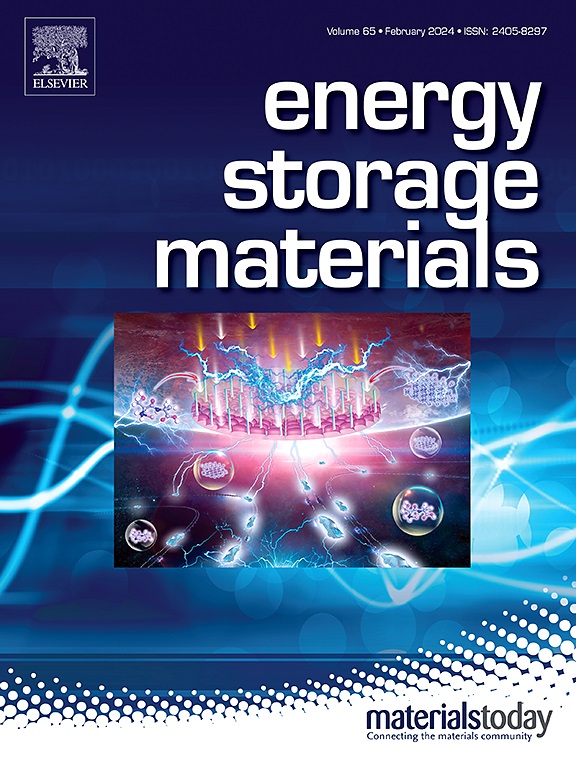Amorphization triggers highly reversible intercalation chemistry in vanadium tetrasulfide for ultrafast aqueous zinc batteries
IF 20.2
1区 材料科学
Q1 CHEMISTRY, PHYSICAL
引用次数: 0
Abstract
Vanadium tetrasulfide (VS4) with abundant inter-chain ion storage sites and cationic and anionic redox centers represents a promising cathode for aqueous zinc ion batteries. However, traditional crystalline VS4 (c-VS4) undergoes irreversible water-participated conversion reactions during cycling, leading to a short lifespan. Herein, we propose a phase amorphization strategy to modulate the conversion reaction of VS4 into highly reversible and fast intercalation chemistry. Specifically, the as-prepared amorphous VS4 (a-VS4) features highly exposed hydrophobic sulfur atoms, avoiding water-participated irreversible conversion and enabling reversible H+/Zn2+ co-(de)intercalation. Simultaneously, the loosely-packed structure of a-VS4 contributes to its isotropic nature and reduced bond energies, facilitating efficient electron and ion transport. Consequently, a-VS4 renders a high capacity of 324 mAh g−1 at 0.1 A g−1, an impressive rate capability of 111 mAh g−1 at 40 A g−1, and outstanding stability with 93.7 % capacity retention after 8500 cycles, far surpassing those of c-VS4 and previously reported VS4 cathodes. Our results offer a new avenue for boosting the zinc storage performance of metal sulfide cathodes.
超快锌水电池中四硫化钒非晶化引发高可逆插层化学反应
四硫化钒(VS4)具有丰富的链间离子存储位点和阳离子和阴离子氧化还原中心,是一种很有前途的水性锌离子电池阴极材料。然而,传统晶体VS4 (c-VS4)在循环过程中发生不可逆的水参与转化反应,导致寿命短。在此,我们提出了一种相非晶化策略来调节VS4的转化反应为高可逆和快速的插层化学反应。具体来说,制备的非晶VS4 (a-VS4)具有高度暴露的疏水硫原子,避免了水参与的不可逆转化,并实现了可逆的H+/Zn2+共(脱)插层。同时,a-VS4的松散填充结构有助于其各向同性和降低键能,促进有效的电子和离子传递。因此,a-VS4在0.1 a g−1时具有324 mAh g−1的高容量,在40 a g−1时具有令人印象深刻的111 mAh g−1的倍率容量,并且在8500次循环后具有93.7%的容量保持率,远远超过c-VS4和先前报道的VS4阴极。我们的研究结果为提高金属硫化物阴极的储锌性能提供了一条新的途径。
本文章由计算机程序翻译,如有差异,请以英文原文为准。
求助全文
约1分钟内获得全文
求助全文
来源期刊

Energy Storage Materials
Materials Science-General Materials Science
CiteScore
33.00
自引率
5.90%
发文量
652
审稿时长
27 days
期刊介绍:
Energy Storage Materials is a global interdisciplinary journal dedicated to sharing scientific and technological advancements in materials and devices for advanced energy storage and related energy conversion, such as in metal-O2 batteries. The journal features comprehensive research articles, including full papers and short communications, as well as authoritative feature articles and reviews by leading experts in the field.
Energy Storage Materials covers a wide range of topics, including the synthesis, fabrication, structure, properties, performance, and technological applications of energy storage materials. Additionally, the journal explores strategies, policies, and developments in the field of energy storage materials and devices for sustainable energy.
Published papers are selected based on their scientific and technological significance, their ability to provide valuable new knowledge, and their relevance to the international research community.
 求助内容:
求助内容: 应助结果提醒方式:
应助结果提醒方式:


